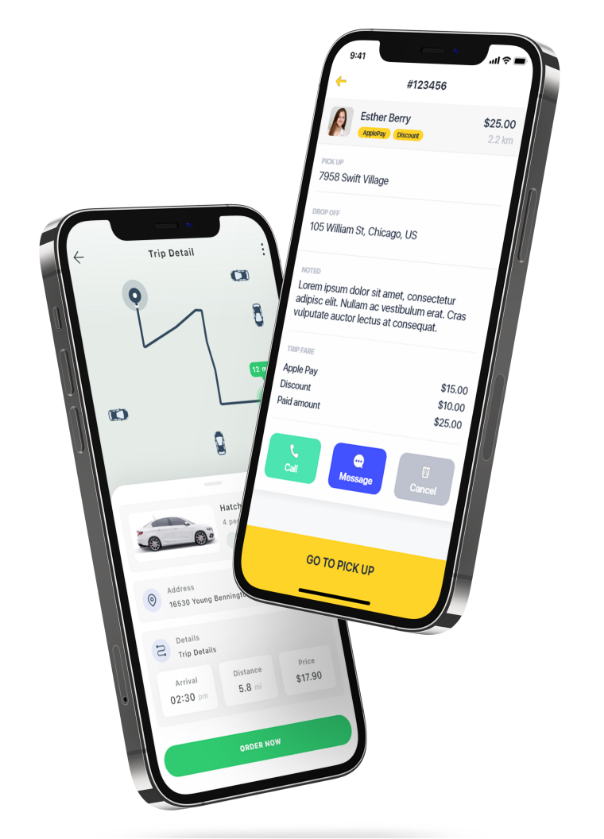As the digital landscape continues to evolve, user-centric design has become a critical component of mobile app development, particularly in the highly competitive taxi app sector. With ride-hailing services like Uber, Lyft, and others dominating the worldwide market, the focus on providing an exceptional user experience (UX) is critical to ensure client pleasure, loyalty, and app viability. The introduction of new technologies and shifting user expectations has spurred innovative approaches to create taxi app design. In this in-depth examination, we will delve into the latest trends that are defining user-centric design for taxi applications, ensuring that they stay intuitive, seamless, and delightful for users.
1. Personalization through Artificial Intelligence (AI)
In the era of data-driven technologies, personalization has emerged as one of the most powerful trends in user-centric design. AI algorithms analyze user preferences, past behaviors, and even external factors like traffic and weather conditions to offer personalized experiences.
How It Works:
AI collects and processes user data to tailor the app interface, ride suggestions, routes, and pricing to individual users. For example, a frequent rider who prefers luxury cars will see those options highlighted, while a cost-conscious user may receive fare discounts or see more affordable ride options prioritized. Additionally, AI can predict users’ needs and suggest future bookings, preferred routes, or time estimates based on their past usage patterns.
Benefits:
- Enhanced customer satisfaction: Personalization leads to a more relevant and engaging experience for users, making them feel valued.
- Reduced decision fatigue: By providing customized recommendations, users can make quicker and more informed decisions without browsing through multiple options.
- Loyalty and retention: Personalized experiences make users more likely to return, increasing retention rates.
2. Seamless Onboarding with Micro-Interactions
User onboarding plays a crucial role in app adoption. Micro-interactions, which are subtle animations or responses within the app’s interface, guide users through the onboarding process in an intuitive and engaging way. Instead of overwhelming users with long forms or detailed instructions, apps are now simplifying the process with step-by-step introductions, friendly animations, and real-time feedback.
How It Works:
When a new user signs up for the app, they are gradually introduced to its features through micro-interactions, such as gentle vibrations when they press a button or visual animations highlighting key functionalities. These micro-interactions create an intuitive learning curve, helping users become familiar with the app without frustration or confusion.
Benefits:
- Improved user engagement: Micro-interactions keep the onboarding process lively and engaging, reducing drop-off rates.
- Guided user flow: Users are guided through the app’s features and functionalities naturally, ensuring they quickly understand how to use the app.
- Real-time feedback: Micro-interactions provide immediate feedback on user actions, confirming that the app is responsive and easy to use.
3. Voice-Enabled Navigation for Hands-Free Operation
Voice recognition technology has become a prominent trend in user-centric design, allowing users to interact with their devices more naturally. Taxi apps are increasingly integrating voice commands to enable hands-free navigation, making it easier for users to book rides, set destinations, or modify their preferences while multitasking or driving.
How It Works:
Users can activate the voice assistant within the taxi app by using a voice command such as “Book a ride to the airport” or “Show my past trips.” The voice-enabled system processes these commands and responds accordingly, eliminating the need for typing or tapping. Some taxi apps even integrate with digital assistants like Siri, Alexa, or Google Assistant, enhancing user convenience.
Benefits:
- Improved accessibility: Voice commands make the app more accessible for users with disabilities or those who prefer voice interaction over manual input.
- Enhanced safety: Hands-free interaction is especially valuable for users who may be driving or otherwise occupied, ensuring they can use the app without distraction.
- Faster interactions: Voice commands speed up the process of booking rides, making the app more efficient and user-friendly.
4. Integration of Real-Time Data for Enhanced Decision-Making
Real-time data integration has become a critical feature for taxi apps aiming to deliver user-centric experiences. Whether it’s showing real-time traffic updates, fare estimates, or driver locations, providing users with up-to-the-minute information allows for better decision-making and smoother journeys.
How It Works:
The app collects real-time data from various sources such as GPS, traffic reports, weather updates, and local event information to optimize routes, offer alternative paths, or adjust pricing dynamically. Users are kept informed about any changes in their ride status or expected time of arrival (ETA) through notifications or alerts within the app.
Benefits:
- Transparency: Users can see exactly where their driver is, how much their ride will cost, and the time it will take to reach their destination based on real-time conditions.
- Dynamic pricing and routing: The app can adjust ride fares or suggest alternative routes based on real-time traffic conditions, ensuring users get the best value for their ride.
- Improved user control: Users can make informed decisions about when and where to book a ride, reducing uncertainty and enhancing the overall experience.
5. Minimalist and Intuitive Interface Design
A cluttered and overly complicated interface can detract from the user experience. Taxi apps are embracing minimalist design principles that prioritize simplicity, ease of use, and an aesthetically pleasing layout. The focus is on reducing unnecessary elements and creating a straightforward, visually clear interface that allows users to navigate the app effortlessly.
How It Works:
Minimalist design often involves using clean lines, ample white space, intuitive icons, and a limited color palette to focus users’ attention on key functions. For example, booking a ride may require just a single tap, with options for ride type, pickup, and destination clearly displayed on the main screen. Complex features are either tucked away in secondary menus or only shown when needed.
Benefits:
- Simplified navigation: A minimalist design ensures users can access essential features without confusion or frustration.
- Reduced cognitive load: By stripping away unnecessary elements, users can focus on what matters most, resulting in a faster, smoother experience.
- Aesthetic appeal: Clean, modern design improves the overall look and feel of the app, making it more attractive to users.
6. Gamification for Enhanced Engagement
Gamification, the use of game-like elements in non-gaming applications, is gaining traction as a strategy to boost user engagement in taxi apps. Gamification rewards users with points, badges, or other incentives for completing actions within the app, such as booking a certain number of rides or referring new users.
How It Works:
Taxi apps integrate loyalty programs, challenges, or interactive features that encourage users to engage with the app more frequently. For instance, users might earn points for each ride they take, which can be redeemed for discounts or exclusive ride options. Badges or status levels can also be awarded for achieving milestones like “100 rides” or “VIP user.”
Benefits:
- Increased user loyalty: Rewards and incentives motivate users to return to the app more frequently and stay engaged for longer periods.
- Competitive differentiation: Gamification sets the app apart from competitors by adding an extra layer of fun and interactivity.
- Enhanced user experience: Gamification adds an element of enjoyment to the ride-booking process, making the app more than just a utility.
7. Multi-Device Synchronization and Cross-Platform Accessibility
In an increasingly connected world, users expect seamless access to their apps across multiple devices and platforms. Taxi apps are adopting multi-device synchronization to allow users to start a booking on one device and continue it on another, ensuring a consistent and uninterrupted experience.
How It Works:
Cross-platform compatibility ensures that the app runs smoothly on smartphones, tablets, wearables, and even desktops. Users can begin interacting with the app on one device (such as requesting a ride on a smartphone) and complete or modify the request on another (such as confirming the ride on a smartwatch).
Benefits:
- Enhanced convenience: Users can switch between devices without losing progress, allowing for a more flexible and convenient experience.
- Increased accessibility: With access to the app on various devices, users can book rides, track drivers, or modify settings no matter where they are or what device they are using.
- Improved user retention: Cross-platform functionality encourages continued app usage, as users are not restricted to a single device.
8. Biometric Authentication for Enhanced Security
Security is a top priority for users, especially in taxi apps that involve personal and payment information. Emerging trends in user-centric design are incorporating biometric authentication methods, such as fingerprint scanning or facial recognition, to offer enhanced security while maintaining a seamless experience.
How It Works:
Biometric authentication integrates directly into the taxi app’s login or payment process, allowing users to confirm their identity quickly and securely without needing to remember passwords or PINs. This adds a layer of protection, reducing the risk of unauthorized access.
Benefits:
- Increased security: Biometric authentication is much harder to breach than traditional methods, safeguarding user data and payment details.
- Seamless user experience: Users no longer need to remember or enter passwords, improving convenience without compromising security.
- Trust and confidence: Knowing that their data is protected by advanced security measures increases users’ trust in the app.
9. Inclusive Design for Accessibility
Designing for inclusivity is an important emerging trend in user-centric design. Taxi apps are focusing on creating interfaces that are accessible to users with disabilities, ensuring that everyone, regardless of physical or cognitive limitations, can enjoy a seamless experience.
How It Works:
Inclusive design incorporates features like larger fonts, high-contrast color schemes, screen readers, and alternative input methods (such as voice commands or gestures). Additionally, the app may offer services tailored to users with specific needs, such as wheelchair-accessible vehicles or assistance for visually impaired users.
Benefits:
- Broader user base: Designing for accessibility ensures that the app can be used by a wider audience, increasing its overall market potential.
- Improved user experience: Users with disabilities can interact with the app more easily, resulting in a more positive experience.
- Compliance with regulations: Many regions have legal requirements for digital accessibility, and apps that comply can avoid potential legal issues.
Conclusion
The emerging trends in user-centric design for taxi apps reflect a broader shift toward providing more customized, frictionless, and engaging user experiences. By integrating cutting-edge technologies like AI, real-time data, voice recognition, and biometric security, taxi apps can meet the evolving needs of their users while setting themselves apart in a crowded marketplace. As the industry evolves, staying ahead of these trends will be critical to providing an exceptional user experience that generates loyalty, happiness, and long-term success.



